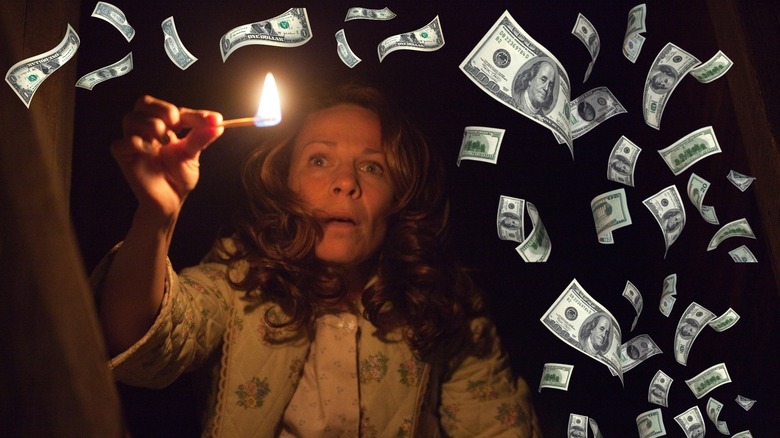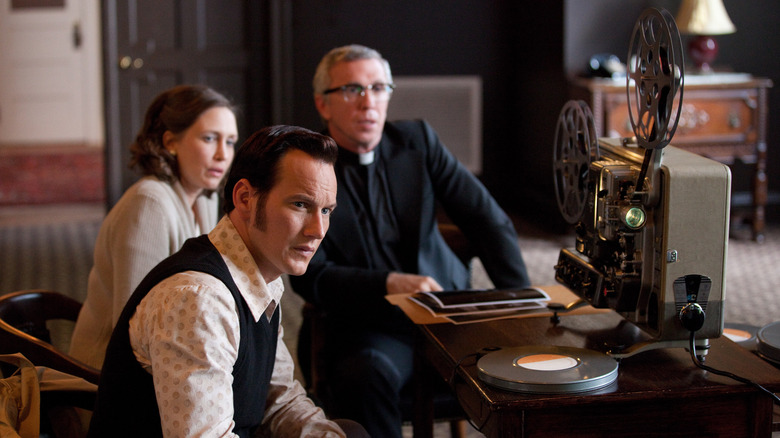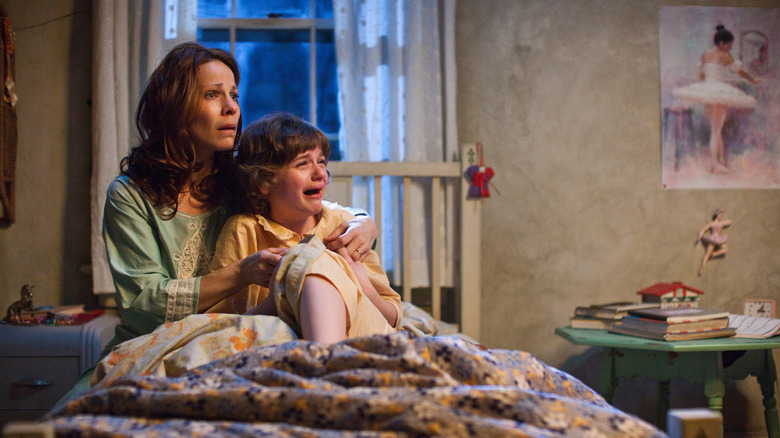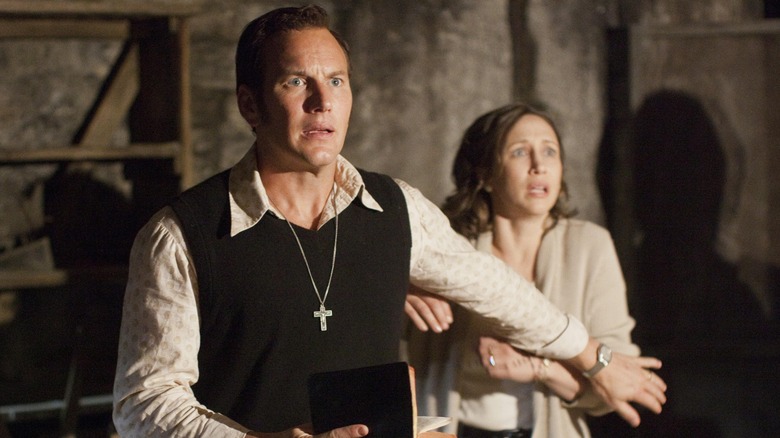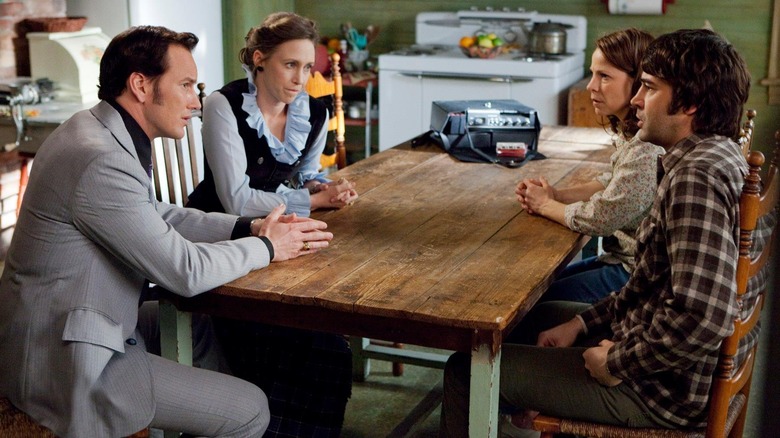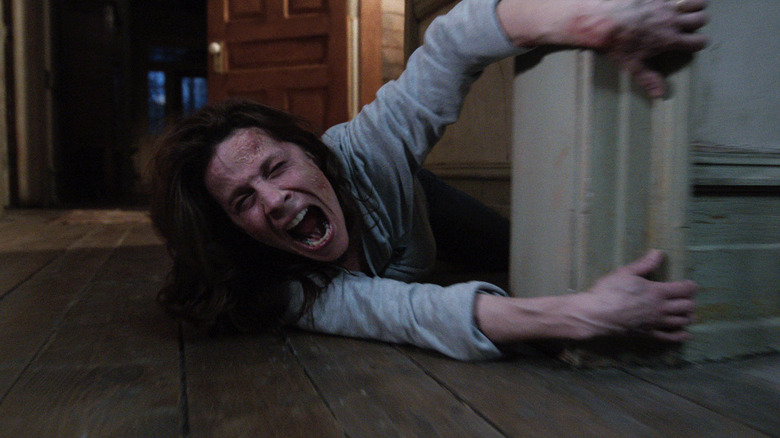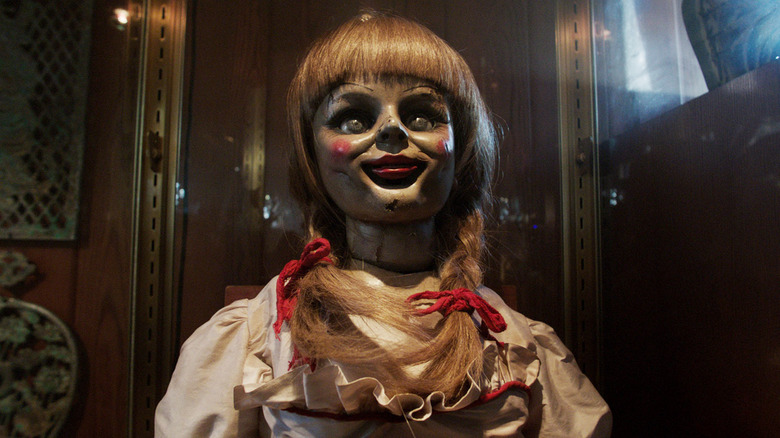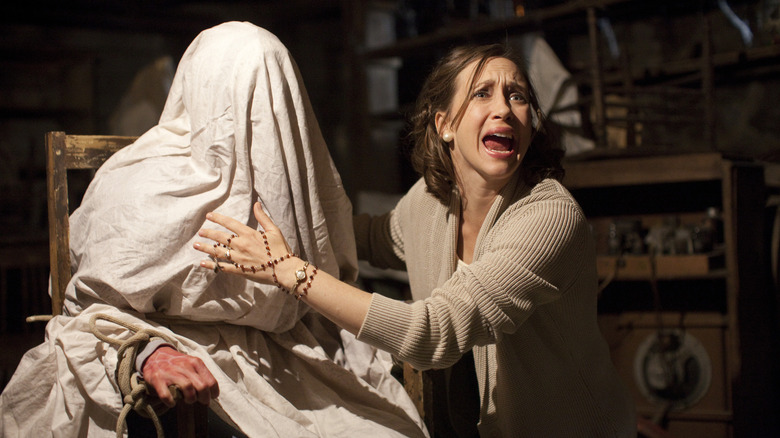Tales From The Box Office: 10 Years Ago, The Conjuring Kicked Off The Biggest Non-Marvel Cinematic Universe
(Welcome to Tales from the Box Office, our column that examines box office miracles, disasters, and everything in between, as well as what we can learn from them.)
Cinematic universes are all the rage now but it's easy to forget how recent a phenomenon this actually is. The notion of a cinematic universe didn't really exist until around 2010 when it became clear what Marvel Studios was doing with its various superhero franchises in the lead-up to the record-breaking "The Avengers" in the summer of 2012. Sure, we had Kevin Smith's films making up the View Askewniverse starting with "Clerks" in 1994 — not to mention Universal's monster movie crossovers from decades earlier. Still, once Marvel perfected the model, Hollywood chased it down rabidly. Sometimes it works, and sometimes it fails spectacularly (we're looking at you, Dark Universe). But arguably nobody has done it better this side of Marvel than James Wan and "The Conjuring" universe.
Wan had established himself as an absolute force to be reckoned with in the horror genre by the time his haunted house tale (inspired by the work of paranormal investigators Ed and Lorraine Warren) hit theaters in 2013. The filmmaker directed the first "Saw," which eventually became a $1 billion franchise, as well as "Insidious," which similarly spawned a behemoth horror series with all of its sequels making big money. Wan's greatest contribution to the genre, however, came when he delivered a paranormal blockbuster for the ages, which paved the way for an entire universe of connected horror tales.
In honor of the recent 10-year anniversary of "The Conjuring," we're looking back at the film, how it came to be following a lengthy development process, the issues it had to overcome on its way to the big screen, what happened when the movie finally hit theaters, and what lessons we can learn from it a decade later. Let's dig in, shall we?
The movie: The Conjuring
The story of "The Conjuring" really starts with the lives of paranormal investigators Ed and Lorraine Warren, who explored many, many cases — and documented them — across decades. Whether or not you believe the stories is somewhat irrelevant as this couple had an absolute treasure trove of horrific tales to tell. As for the movie, it starts with producer Tony DeRosa-Grund. He sat down to listen to an original recording with Carolyn Perron (played by Lili Taylor in the movie). Ed Warren said to DeRosa-Grund, "If we can't make this into a film I don't know what we can."
What the producer discovered that day was the tale of the Harrisville haunting, which served as the basis for the film. It tells the allegedly true story of paranormal investigators Ed and Lorraine Warren, who were called to help a family terrorized by a dark presence in a secluded farmhouse. Things get absurdly creepy and terrifying from there. DeRosa-Grund set about writing a treatment after meeting with Warren. As is so often the case, the project wound up in development hell.
Eventually, the producer landed a deal with Gold Circle Films, of "The Haunting in Connecticut" fame, to produce the movie after more than a decade of trying to get a deal done. Unfortunately, the deal fell through in the contract stage. At this time, DeRosa-Grund aligned with producer Peter Safran (now the co-head of DC Studios), who brought on Chad Hayes and Carey W. Hayes to rework the screenplay.
That's when everything changed and, in 2009, a six-studio bidding war broke out, with Summit Entertainment winning the rights. But that's not all! Yet another speed bump emerged as the deal with Summit couldn't be finalized. That paved the way for New Line Cinema to swoop in though, as they had been in the mix during that initial bidding war.
James Wan steps up to the big leagues
A deal was finally done in November of 2009 and the movie had a real home. Now, it was about finding the right person to bring this spooky tale to life. Enter James Wan. The filmmaker, as mentioned, had turned in some big hits already in his career, but all of those were of the low-budget variety. His only slightly bigger budget play, 2007's "Dead Silence," didn't pan out as it only made $22 million worldwide against a $20 million budget. But with two franchise-generating monster hits under his belt, the man had proven himself. He seemed to be a perfect fit when Warner Bros. and New Line picked Wan to dig into the case files of the Warrens in late 2011.
The difference here is that Wan would be playing in a larger sandbox again as "The Conjuring" would be made on a $20 million budget with the backing of a major studio. They quickly set about casting, with Wan reuniting with Patrick Wilson, whom he worked with on "Insidious," as the actor was cast as Ed Warren. Joining him as Lorraine Warren was Vera Farmiga ("The Departed"). Ron Livingston and the aforementioned Lili Taylor would join as the heads of the Perron family, with Shanley Caswell, Hayley McFarland, Mackenzie Foy, and a young Joey King filling out the core ensemble.
Wan and the studio wasted little time getting things going once the filmmaker entered the picture. Filming kicked off in February 2012 and seemed to go off without a hitch. Wan even filmed in chronological order, which is pretty out of the ordinary for any film, let alone a sizable studio horror flick.
Trouble behind the scenes
The whole experience went so well that Wan decided he was pretty much done with the indie film world. Speaking to ComingSoon ahead of the movie's release, Wan explained:
"I think I realized from doing 'The Conjuring' and dropping down to a more indie schedule, I think I'm done with the indie world. [...] I think part of the reason why 'The Conjuring' is playing so well is having the budget to do it right and having the schedule to do it right allows me, as a filmmaker, to show folks I'm not this rough film student guy. [laughs]"
While production itself didn't really experience any notable speed bumps, after the movie was in the can, some issues emerged. For one, the title briefly changed to "The Warren Files" before reverting back to "The Conjuring." However, that would end up becoming a sticking point as well. Tony DeRosa-Grund ended up trying to double-dip in making a deal with Lionsgate for a TV series that was not coincidentally also titled "The Conjuring." This didn't sit well with Warner Bros. and New Line. Legal action followed. It was all quite messy but was eventually settled out of court in 2017 — long after the movie had enjoyed a shocking amount of success.
Horror in the summertime
Legal action aside, Warner Bros. and New Line were extremely excited behind the scenes, as several test screenings for the film were through the roof, well beyond expectations. So, in a very, very rare move, the studio decided to push "The Conjuring" to summer 2013, a season typically reserved for bigger blockbusters or family fare. As Variety explained at the time, it would be the first horror movie to open wide in theaters in June or July since "The Omen" in 2006.
Then-Warner Bros. distribution chief Dan Fellman explained, "I said to [New Line Chief Operating Officer] Toby Emmerich, 'Let's take a chance.' Horror movies tend to get bunched together and then drop off quickly, but they don't have to." It was a great show of confidence and one that would prove to be rewarded (more on that in a moment). But they did have one more hurdle to clear in the form of the MPAA.
While it's not uncommon for a horror movie to receive an R rating, we're typically dealing with far more violent movies when that does happen. The studio and Wan were aiming for PG-13 with their take on this real-life haunting, but the MPAA wasn't having it as they gave the film an R "for sequences of disturbing violence and terror." Yes, as silly as it sounds, that R rating was handed out because the movie was just so damn terrifying. "It's just so scary. [There are] no specific scenes or tone you could take out to get it PG-13," producer Walter Hamada said at WonderCon that year. And so, it went to theaters with an R rating, which didn't end up hampering the movie it all.
The financial journey
Warner Bros. launched a pretty impressive marketing campaign for the film and leaned into the "true story" of it all. A late-stage trailer even featured members of the Perron family recounting the horrors to help drive home the point. But the theatrical trailer also sold something far above the typical haunted house flick, with the now-infamous "clapping" gag sticking out as something that really got under one's skin. Even so, "The Conjuring" didn't have it easy on opening weekend, as we were in the midst of a very crowded summer season.
The movie was released domestically on the weekend of July 19, with "Turbo," "Red 2," and "R.I.P.D." also hitting theaters that same day. So, we had a family-friendly animated film, a sequel to a successful action flick, and a big-budget franchise play starring Ryan Reynolds. In the end, "The Conjuring" stood tall above the competition, easily taking the number one spot with a $41.8 million opening. It was an instant smash.
The film had to surrender the top spot to "The Wolverine" the following weekend, but it still held remarkably well in the face of such competition. All told, Wan's tale of the Warrens pulled in $137.4 million domestically alone to go along with a stellar $182 million internationally for a grand total of $319.4 million worldwide. Or, to put it another way, just shy of 16 times the production budget. There were absolutely bigger hits that year such as "Frozen" and "Iron Man 3," but in terms of return on investment? It's hard to argue against "The Conjuring," particularly because this was just the beginning of something much, much bigger.
The Conjuring universe expands
Studios pretty much always make sequels to successful horror hits. That was never really in question here and yes, we've had two proper "Conjuring" movies in the years since the original, with "The Conjuring 2" hitting theaters in 2016 and doing comparably big business ($310 million worldwide/$40 million budget). But what Warner Bros. and New Line did was think bigger by first creating a spin-off for the creepy doll featured in the first film, "Annabelle." They made quick work of it, with the film hitting theaters in October 2014. The key difference is that critics were largely unimpressed with the spin-off, whereas "The Conjuring" was met with a great deal of praise from critics and audiences alike. It didn't matter.
The good name of "The Conjuring" pushed "Annabelle" to $257 million worldwide against a mere $6.5 million budget. A cinematic universe was born. In the years since, we've also had "Annabelle: Creation," "The Nun," "Annabelle Comes Home," and "The Conjuring: The Devil Made Me Do It." There's also been debate as to whether or not 2019's "The Curse of La Llorona" counts as Annabelle makes an appearance. Either way, it was a successful movie ($123 million worldwide/$9 million budget) that sure as heck didn't suffer for its close associations with the franchise.
If we count "La Llorona," "The Conjuring" universe has scared up $2.1 billion at the global box office across eight movies, with a ninth on the way in the form of "The Nun 2" later this year. That movie's prospects are quite good, too, seeing as the original "Nun" is actually the highest-grossing entry in this franchise to date (with $363 million to its name). All of the movies combined have budgets that total less than $180 million, meaning that Warner Bros. has earned more than 10 times its investment (not accounting for marketing). Pound for pound, no cinematic universe that has sprung up over the last decade can touch that success rate. It's really not even all that close.
The lessons contained within
One thing that has always stood out about "The Conjuring" is that the studio didn't try to do too much too fast. They tried to make one good movie, knowing that there were more stories to tell if things went well. But they didn't get ahead of themselves and kept all eyes on the prize before them. Beyond that, Warner Bros. and New Line took the film very seriously, gave Wan the resources he needed, and treated it like an honest-to-goodness studio film, rather than a quick cash cow. Horror has always been there to help Hollywood make money, but good things can happen when the genre is treated with reverence and not as being inferior.
But the bigger lesson is and always has been about building a cinematic universe the right way. With the exception of the first "Annabelle," this is a series that has always retained an element of quality and the movies are never rushed. There's no "we need two of these in theaters per year" mandate. The movies come when they're ready. These films are also very good at course correcting, as "Annabelle: Creation" is miles better than its predecessor, for example. This mighty wall was built one brick at a time.
In contrast, Warner Bros. jumped the gun with the DC Extended Universe around this time after "Man of Steel" came out, opting to let Zack Snyder direct "Batman v Superman: Dawn of Justice" and "Justice League" back-to-back. In many ways, the studio is still suffering greatly from that decision. We can also look at Universal's Dark Universe, which both kicked off and ended with Tom Cruise's "The Mummy" in 2017. Yet, the studio announced a slew of connected films (including "The Invisible Man" and "Bride of Frankenstein") that never came to pass. Too much, too soon.
In short, these things can't be rushed and there's no substitute for quality. Want to build a universe? Make a good movie first, then try to make another one. Wash, rinse, repeat.
